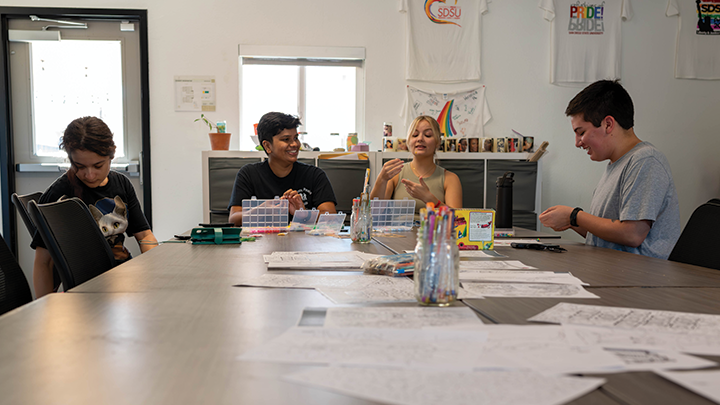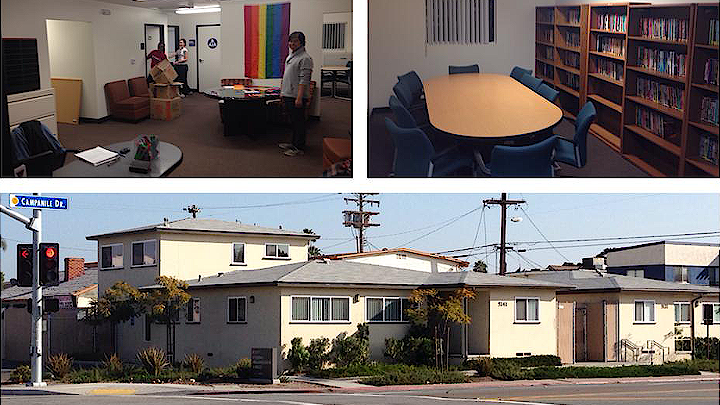A little over 10 years ago on Jan. 22, 2014, a resource center opened in an old fraternity house off the corner of Campanile Mall Drive and Lindo Paseo Drive.
For most of the San Diego campus, the opening was celebrated with little fanfare, overshadowed by the grand opening of the Conrad Prebys Aztec Student Union, which occurred on the same day.
The space was humble: Much of the furnishings were gently used items from other parts of campus, and there was a foot of sand that had to be removed from what would become the space’s patio, as well as other vestiges of the previous tenants.
But for members of San Diego State University’s queer community and their allies, the two-story house represented a long-sought home, a safe place where Pride was embraced.
It was a place they could call their own, finally.
The Pride Center was the physical manifestation of almost five decades of activism by the 2SLGBTQIA+ staff, faculty and students and their allies.
A decade later, The Pride Center space is bursting with activity and life, as it continues its mission to create, sustain and strengthen an open, inclusive, safe and affirming gathering space and campus environment for individuals of all sexual orientations, romantic orientations, gender identities, and gender expressions, as well as their allies.
The Pride Center will celebrate its 10th anniversary with an open house from 3-5:30 p.m. Jan. 31 at 5141 Campanile Mall Dr.
“The Pride Center is known for many things and reaching our 10 birthday is a milestone to celebrate,” Pride Center Director Kay Wong said. “Not only does it gesture to the SDSU community that they can be themselves on campus, it signals to the entire Cal State system that transcending boxes, labels and systemic oppression in hopes of creating a world full of belonging and liberation is a value of the institution.”
The Road to The Pride Center
2SLGBTQIA+ activism on SDSU’s campus dates back to the early 1970s, namely to the founding of the Gay Liberation Front in 1970 by Bob Brunsting, the creation of the Women’s Studies department — believed to be the first such department in the U.S. and a powerful ally of the 2SLGBTQIA+ movement throughout its existence — and the creation of the Gay Students Union in 1975.
There were three efforts to establish a brick-and-mortar center on campus, the first in 1998, a second in 2008 and the final, successful attempt that began in 2011.
That’s when the Cross Cultural Center opened a space in its center for LGBT students, which became known as the “LGBT Cubicle,” and also created an LGBT Resource Initiative. It was chaired by Doug Case, the longtime adviser of Delta Lambda, the campus fraternity for gay students, and Randy Timm, who currently serves as the assistant vice president for Campus Life and dean of students.
It became clear, Timm said, that the cubicle was a stopgap, and a larger, stand-alone space was needed.
“The Cross Cultural Center served as an incubator for many of the resource centers we know today,” Timm said. “But with anything that is incubated, it ultimately grows. And when it does, it will need space to spread its wings to truly realize its potential.”
Case and Timm, in turn, recruited advocates and activists among students, staff and faculty to form the LGBT Advisory Board. The board, which would hold meetings in the Lipinsky Suite in Student Services West, was charged with crafting a proposal for an LGBT Resource Center.
Timm said the group came up with a multipoint action plan that included reinvigorated calls for a stand-alone resource center funded out of the university budget, not contingent on endowment funds or the Associated Students budget, both of which were subject to fluctuation.
The difference between the decisive effort and previous efforts?
“We were organized,” Timm said. “We worked together to clearly communicate the needs of our community. The voices for change didn't just come from one area or department; it was the unity of faculty, staff and students all speaking the same concerns and firmly — but caringly — pressing for change.”
Then -SDSU President Elliot Hirshman approved the creation and funding of the center in the 2013 Strategic Plan with a base funding of $200,000. By October, The Pride Center hired its first full-time coordinator, Anthony Keen, who had been a residence hall coordinator at the university.
The center operated in Student Services West while the permanent space was readied for occupancy.
Folks who were familiar with the space in its infancy recalled how renovating the space required the removal of remnants of the fraternity that occupied the space beforehand, such as a dancing pole in what would become the main office and sand from a volleyball court that when removed would become the space for the patio shared by The Pride Center and the Women’s Resource Center, which opened a year later. Because of the requisitioning process for equipment, it took nearly six months before the space had a microwave oven or mini refrigerator.
But even with the early challenges, the center’s impact upon opening was immediate.
“While there was not a lot of fanfare outside of the university or across campus, the opening of the center was definitely a historical moment for the 2SLGBTQIA+, queer, and trans communities,” Timm said. “Many people had tried to make this happen for years. Our community experienced a lot of pain over the years. This was a moment where we felt seen and part of the One SDSU community.
“You might say there was a lot of pride in The Pride Center opening,” he said.
 Staff and students gather inside The Pride Center. The center will be hosting an open house in celebration of its 10th anniversary, January 31 from 3-5:30 p.m. (Erik Good/SDSU)
Staff and students gather inside The Pride Center. The center will be hosting an open house in celebration of its 10th anniversary, January 31 from 3-5:30 p.m. (Erik Good/SDSU)
Pride Today
With each month, the center added programs, support groups, resources and services for students and began to work with the campuses’ existing 2SLGBTQIA+ campus organizations. And its staff continued to bolster the appearance of the physical space.
Students said The Pride Center was one of the few places on campus where they felt safe.
Brenda Drew, who graduated from SDSU in 2023, recalled vividly looking for their place on campus when they arrived in 2018. Drew, who identifies as queer and nonbinary, grew up in what they called an “ultraconservative, religious Black household,” where they often had to hide their true, authentic self.
“As an undergrad student and employee, The Pride Center represented home, safety and family to me,” said Drew, who served as a Pride Center educator until they graduated in December, but one day hopes to become the center’s director.
Ian Mariano Von Dyl, a third-year international business major, came out as gay in winter 2019, just before the start of the COVID-19 pandemic. When he arrived at SDSU in fall 2021, he knew he wanted to live openly out and chose to live on the Pride House floor, a learning community for 2SLGBTQIA+ students that is a collaboration between The Pride Center, Housing & Residential Education and the LGBTQ+ Studies department .
His first year was such a positive experience that he decided in his second year to work for The Pride Center.
He said Pride House and The Pride Center mean the world to him.
“When I think about what The Pride Center means to me, I think back to my first year at SDSU and being part of the Pride House mentoring program where I was able to build a community with folks around me,” Von Dyl said. “Now as a student staff at The Pride Center, it is a space that allows me to help build community for others and support 2SLGBTQIA+ folks while participating in advocacy work.”
Today, the center features signature events such as Trans Week of Empowerment, Lavender Graduation, the Pride Flag Raising ceremony and coordinating SDSU’s Pride contingent in July as part of San Diego’s Pride Month festivities, Black Gay Pride Week and the November Trans Day of Remembrance and year-round peer-led programming.
It also houses SafeZones training; Pride House, a collaboration between the Pride Center, a peer mentorship program for first-year undergraduate students; the Queer Trans Person of Color Retreat, among other programs.
As a result of these programs, SDSU has been recognized as one of the “Best of the Best” for LGBTQ students, scoring a 5 out of 5 on the Campus Pride Index.
“Through self- and collective care, The Pride Center opening tells 2SLGBTQIA+ folks, including myself, that there is nothing wrong with us, that we don’t have to figure everything out all at once or at all, that we are not an equation or mystery to solve, but rather nuanced and complex beings full of dreams and imagination,” Wong said.
The Future of Pride
The anniversary gives everyone who’s been involved with The Pride Center a chance to reflect not only on the journey it took to get to this point but also on the road that lies ahead.
Timm, who in his job oversees the campus’ undergraduate student body, said The Pride Center’s purpose is more important than ever and has had a profound impact on not only the 2SLGBTQIA+, queer, and trans population on campus but the student body in general.
“The ability to be seen and have a safe space to turn to is incredibly important, and the awareness that the center has raised around the campus at large is incredibly vital, which I believe has also impacted student success,” Timm said. “But we also realize that challenges still exist.”
Timm said the California State University system does not disaggregate 2SLGBTQIA+, queer and trans student data so the impacts of programming can’t be statistically quantified, something he wishes would change.
“The university system treats it like a privacy issue … it’s an identity issue,” Timm said. “We should be represented in the data just like any other identity, but we’re not.
“There is still more work to do, and I think this celebration isn’t a checking off of a box, but a moment to say we have to continue to do better, and we will.”
Wong said the work also includes facing harmful rhetoric and legislation aimed at trans and nonbinary individuals head-on.
“While The Pride Center has curated a special space that can’t be defined with words, we know there is so much to dismantle, and, as such, updated our mission statement in 2022 to reflect our hopes and visions for the future,” Wong said. “It feels like each day there is new legislation targeting the 2SLGBTQIA+ community, many specifically harming trans and nonbinary individuals.
“Over the next decade, our goal is to continue being a countrywide example of what it means to intentionally show up for and evolve with the 2SLGBTIA+ community. Personally, I am eager to see what impacts we will have through our continued partnerships and amazing internal staff.”





